-
DWELLING IN THE FUCHUN MOUNTAINS 富春山居圖 ( Gu Xiaogang 2029)
GU XIAOGANG: DWELLING IN THE FUCHUN MOUNTAINS (2019)
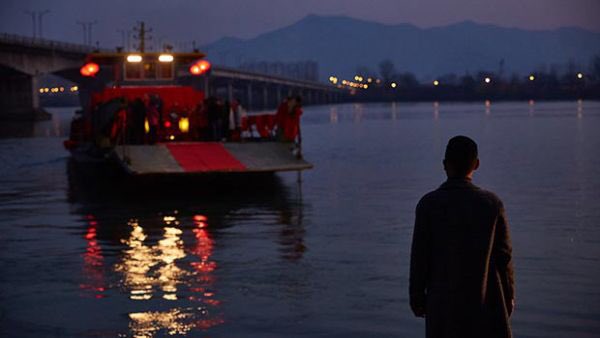
[Watched; not reviewed]
Dwelling in the Fuchun Mountains
Gu Xiaogang, China, 2019, 150m
Fuyang dialect and Mandarin with English subtitles
New York Premiere
Taking its title from a renowned 14th Chinese scroll painting by Huang Gongwang, this debut feature from Gu Xiaogang is a panoramic evocation of one year in the life of a provincial family. In tribute to its artistic inspiration, the film often presents its action from a quiet distance, the camera lyrically moving across the frame as its central characters—the members of the sprawling Yu family, overseen by an aging matriarch (Du Hongjun), whose birthday celebration opens the film—deal with business and romantic entanglements, financial debts and work struggles. All the while the seasons inexorably change. Dwelling in the Fuchun Mountains was shot over the course of two years, and is the first in a declared trilogy of films about life along the Yangtze River—a first-time filmmaker’s labor of love that’s as accomplished as it is ambitious.
Dwelling in the Fuchun Mountains 富春山居圖, 150 mins., debuted at Zurich; nine other international festivals, including Zurich, Hamburg, Vancouver, Busan, ,Tokyo, Rotterdam, Gothenberg and New Directors/New Films; it is not included in the delayed virtual Dec. 2020 version of ND/NF, however.
Last edited by Chris Knipp; 12-15-2020 at 01:23 AM.
-
SERVANTS (Ivan Ostrochovský 2020)
IVAN OSTROCHOVSKY: SERVANTS (2020
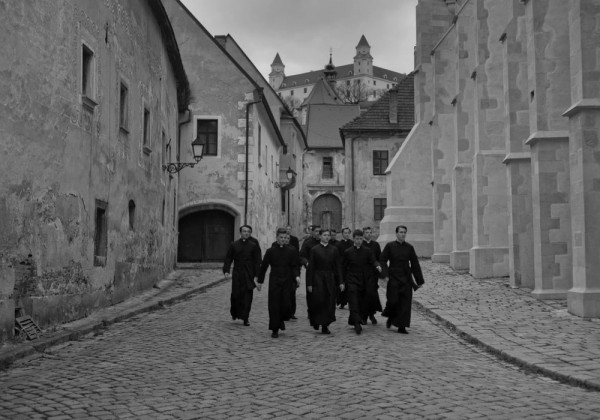
Aesthetics triumphs over story in this tale of Soviet era religious repression
Slovak filmmaker Ivan Ostrochovský's movie shows the aesthetics of totalitarianism. The focus is a seminary in 1980 during the period (1971 to 1989) when "Pacem in terris" was a decree and a body that existed in Czechoslovakia, created to repress Catholicism, and some of the priests and their acolytes rebelled, resulting in brutal repression.
It's all shown in academy ratio and black and white in the velvety cinematography of Jural Chlpik accompanied by a menacing, throbbing score. Every scene is beautifully composed. Cold stone and snow add to the contrast. The novitiates, some handsome, trim in their long black soutanes, enhance the graceful uniformity of the images, and a scene of a mountain town has medieval charm.
One could just sit and admire the sound and pictures, but this is about modern history. What's going on is ugly, and, indeed, comes on wearing the air of a noir thriller. "Where're not here to enjoy ourselves," says a priest to a boy at one point, and that's putting it mildly. If you find it hard to see being Catholic as being free, the action may confuse you. These young men, seeking a life of the cloth, find its expression stifled. One must imagine, if one's in a very special place to cultivate one's religion, and one is hampered at every turn, because the regime sees one's Church as a threat, the oppression is outside the house.
There's a priest beaten and murdered and dumped out of a trunk under a bridge. There is a hunger strike. A couple of the novitiates are eliminated. Much is going on here. But it's conveyed collectively, like a dance. We don't get to see all the young men in any detail. Even courtyards are often seen from above, like a mouse cage. Most of the action is seen from the point of view of two newly arrived novitiates, Michal (Samuel Polakovic) and Juraj (Samuel Skyva), who see things are not as they should be and grow growingly tense and outraged. As the noirish strain grows, there is a growing fear by some priests that there is too much independence here among the boys, and the seminary will be shut down. They are being put under pressure to act as informants on any nonconformist behavior, or be removed and sent into the army. It's all like a deadly, nightmarish dance. One can admire Ostrochovský's artistry, while feeling the cold beauty somewhat blurs the story details. Handsome film, though.
Servants / Služobníci, 80 mins., debuted at Berlin, Feb. 2020 and was included in a dozen or so international festivals, winning a number of nominations and awards.
Last edited by Chris Knipp; 05-10-2021 at 09:28 AM.
-
ANNE AT 13,000 FEET (Kazik Radwanski 2019)
KAZIK RADWANSKI: ANNE AT 13,000 FEET (2019)
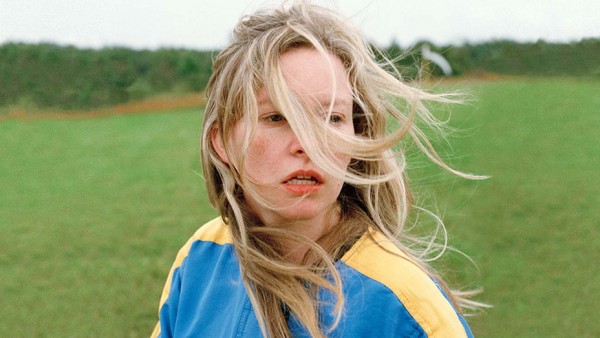
DERAGH CAMPBELL IN ANNE AT 13,000 FEET
Portrait of a woman in dysfunction
Anne (Deragh Campbell) is seen almost nauseatingly up close in this minimalist, leanly edited, music-free portrait of a dysfunctional young woman trying to set out on her own. We see her twice, start and finish, sky-dive from a small plane, and it's not a more out-of-control moment than usual. In fact, while falling through the air is one time when Anne isn't likely to do something unpredictable and disruptive. She moves out from her mother to her own place, takes a part0time daycare center job and starts dating a guy, but does this mean she's got things under control or is out on her own? Not really. Radwanski, his star, and his editor are doing top work here. There's only the little nagging question: is it worth it?
Deragh Campbell has been seen in a number of ND/NF films, including last year's oddball MS Slavic 7, and Radwanski produced another portrait of a lost adult child, Tower,, seen in ND/NF 2013 (I rated it "sub mumblecore") The current effort, which takes us through Anne's moments of charm and strong empathy with children at the daycare and her childlike clumsiness with fellow workers and social contacts, has been compared to John Cassavetes working with wife Gena Rowlands in A Woman Under the Influence, but maybe those who're making that comparison need to go back and look at the original. This film feels more like a reality show. There is a lack of depth or humanity here.
Anne at 13,000 Feat, 75 mins., debuted at Toronto Sept 2019, and was shown at a half dozen other festivals in 2020 including Vancouver, AFI, Portland, and now, ND/NF which was postponed from Mar. to Dec. 2020 due to the paneemic.
Last edited by Chris Knipp; 12-15-2020 at 10:29 AM.
-
TWO OF US / DEUX (Filippo Meneghetti, 2019)
FILIPPO MENEGHETTI: TWO OF US/DEUX (2019)
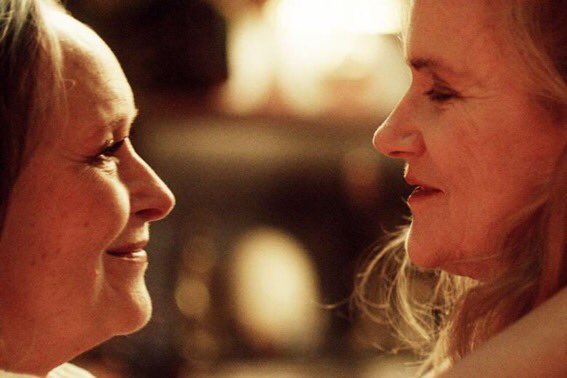
MARTINE CHEVALLIER, BARBARA SUKOWA IN TWO OF US/DEUS
Secret lesbian romance leads to complications in Italian Filippo Meneghetti's directorial debut, in French and set somewhere in the south of France and shot near Montpellier.
Former tour guide Nina Dorn (the handsome Barbara Sukowa, a protegee of Fassbinder), who lives in a facing apartment on the top floor of the building, has long been the lover of Madeleine (Martine Chevallier of the Comédie-Francaise), but secretly; no one, even Maddie's adult divorced daughter Anne (Léa Drucker), knows about this relationship, though how very loving and happy it is we are shown very clearly in scenes of sweetness and smiles. The couple is well into retirement age, but only now they are planning to sell Madeleine's very nice apartment and go to live together at last, in Rome where they met so many years ago. An Italian version of a corny but romantic pop song is their reminder of that moment; they dance to it still.
The plan is for Maddie to tell Anne about the relationship and the plan. Not surprisingly, after all these years of secrecy, in the event, at the end of a birthday dinner for her, she chokes. She just doesn't seem to be ready to do it. When Nina finds out this change of heart from the real estate agent, it's beyond disappointing and into infuriating. Nina speaks harshly with the more conventional Maddie in the street in front of the estate agent.
The result of this spat is dramatic indeed. Shortly thereafter, Maddie has a stroke. The bulk of the movie is what happens after that.
The film has had a good reception in France. It is slated for US release by Magnolia in Feb. 2021. It's in a good position, but its status as a bold work by a new director fits it, marginally, for the New Directors series, though it seems like firm arthouse material. I sympathize with the writer for the French publication Les Inrockuptibles who said it took two great actresses to crack the code of the sometimes clumsy and maladroit direction. There are many early hints, for instance, of a distance between the two women that are not appropriate; the camera is often either too close or too far away. Expressionism wasn't needed!
Meneghetti stirs up a good deal of melodrama, where it might do better to have drawn up a screenplay that showed how such very human problems might be safely resolved. After a while, we're just in a movie. The action seems to me rather implausible, and at once too eventful and too slow. But the look of the film is handsome, and the ladies are, needless to say, magnificent. Numerous viewers (Letterboxd, for instance) have expressed gratitude for a movie about older lesbians, and asked for more. In that this is welcome. Women who identify with Maddie and Nina will appreciate this film, even though its story details may not have that much to do with them.
Two of Us/Deux, 95 mins., debuted at Toronto and showed in at least 15 other international festivals, including ND/NF, as part of the virtual form of which it was reviewed for this film. AlloCiné press rating 3/6/5.
Last edited by Chris Knipp; 05-10-2021 at 09:32 AM.
-
RED MOON TIDE/LÚA VERMELHA (Lois Patiño 2020)
LOIS PATIÑO: RED MOON TIDE/LÚA VERMELhA (2020)
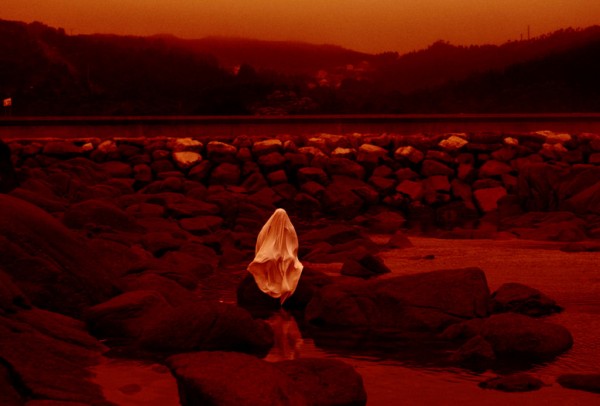
STILL FROM LUA VERMELA
Gorgeous images of a haunted world staged along the Galician coast of Spain
The young Spanish filmmaker Lois Patiño has a penchant for haunted, beautiful landscapes and for the human history embedded in his own native landscape. In this film the focus is on a fishing village along the Galician coast, rock tides, and death in the water. Village people, engaged for the film enterprise, lend their stubby bodies and stolid gazes to Patiño, who uses them arrestingly as statues or mannequins posed near the water, in a small grove, in an awesome, empty building, or in a quiet, old fashioned family house interior.
A simple narrative theme runs through the images. Rubio (Rubio de Camelle) is a fisherman who is also diver who has specialized for years in retrieving drowned bodies from shipwrecks, who himself has disappeared, and villagers speculate about whether he will reappear. He believed a monster is hunting the shores of his coastal town as he discovered corpses around as he takes his boat out in the morning. Now his boat has run aground, without Rubio. Gradually statue-like figures appear around in landscapes and architectural interiors, tall, thin, immobile, draped in shimmering white. There is talk of phantoms and ghosts and demons and three witches coming for people. Themes of death and the water come and go.
It's impossible to exaggerate how subtle and beautiful these images are, the soft yellow-filtered tints, the reds, the textures of cloth: everything is like a sculpture or something made out of sewn cloth. And the colors, toward the end, when red begins to prevail, you can lose yourself in them. It is indeed a gorgeous picture of a phantom world, dreamland, nightmare, or perverse paradise? The scenes unfold, one after another exquisitely composed tableaux that transform what might in some cases be only ordinary images of everyday Spanish village life into mythical wonders. And the moons! The 37-year-old Patiño has mastered the art of turning images of everyday lives into the mythical.
This is filmmaking that is largely a celebration of the visual. The dreams or nightmares of a lost fisherman and a world of lost souls, a project long in gestation are nonetheless somewhat underdeveloped as narrative. But if you're willing to sit back and enjoy the eye candy, there's something rather unique here. The transition from his short films to this feature length has been a little uneven. This may be a pretty long slog for some people.
In an interview with Film Comment, the filmmaker has said that this long-gestating film was at first meant to be more of a documentary. But, I'd say, he is just too much of an artist and a dreamer to be contented with the real. Toward the end of the process of making Red Moon Tide, he says he "got very deep into H.P. Lovecraft," so he "eventually tried" to "bring the story a little towards the terror genre." Everything he loves and knows, he put into it. It's thus a film to study more than simply go and watch.
Red Moon Tied/Lua vermelha, 84 mins., debuted at the Berlinale Feb. 2020, also showing at Malaga, IndieLIsboa and Toulouse. Screened for this review as part of the delayed FLC New Directors/New Films 2020, online Dec. 2020.
Last edited by Chris Knipp; 12-19-2020 at 01:49 AM.
-
ATLANTIS ( Valentyn Vasyanovych 2019)
VALENTYN VASYANOVYCH: ATLANTIS (2019)
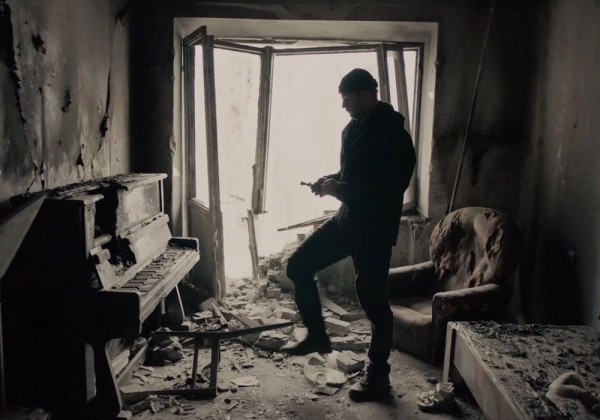
ANDRIY RYMARUK IN ATLANTIS
Ravaged young war veteran winds up helping people bury their dead: a formal survey of the physical and human toll of post-war Ukraine
Dennis Harvey's Variety review says simply, "Its cryptic, rigorously minimalist progress will test the patience of many viewers and present a challenge for commercial placements." So that is Atlantis in a nutshell. It may seem more like serving a stint in the military than watching a movie. You do get more of a look than you've ever had before of forensic examinations of long-dead corpses. But that is repeated more often than necessary, unless you are going to work for a coroner. Nonetheless Atlantis, set in Eastern Ukraine in 2025, is the tale of a young man who has been a solider in the war with Russia and slowly works his way back to something more like human life, and seems to succeed. The first time director who won first prize in the Horizons section at Venice this year with the film also succeeds in delivering a valid picture of the punishing series of steps that might be necessary for such a process as this. The punishment, for us, is mitigated after a while at least by appreciation of the formal elegance and control of the consistent sequence of horizontal compositions, with fixed camera positions.
When we meet Sergiy (Andriy Rymaruk) he's living in an isolated location with a war comrade and all they do in their spare time is target practice using big metal human targets. Their attempt at civilian life is very partial, consisting only of work at a steel mill about to be closed down. Such a clangorous environment isn't good for people with PTSD, and it takes a severe toll on Sergei's roommate.
Sergiy makes his way by accident to the forensic archaeology, as it might be called; a woman he works with turns out to have been an archaeology student, in fact. She considers this a logical continuation, archeology on ourselves. He has met her and gotten into this because he rescued her and her partner when their truck was stuck along the road as he was going on a long trek in a bigger truck.
In some of these scenes I felt I was in a Soviet social realist painting. The sense of focus on the function, not the individual, is intense.
One of the most memorable and unusual moments is the scene where Sergiy explores a cavernous building that leads to a room with a small piano. One assumes it may be where he used to live. It's all a wreck now, and yet, you wonder why he doesn't try to play the piano, which is more or less intact. Instead he quietly sets a Christ Crucified figure up on the piano top. While so many of the sequences seem more like demonstrations of equipment than experiences, this has the haunting quality of a ceremony and a dream.
As the Variety review says, most of this film is made up of "prolonged, stationary, symmetrically formal widescreen compositions of activity within various harsh vistas and decrepit interiors." This one departs from that. But toward the end, a relationship develops that shows Sergiy hasn't lost all ability to function as a human being. There's hope, for him. For the Ukraine territory where the fighting was, an expert assesses that it's uninhabitable - for decades, maybe hundreds of years. They won the war and destroyed the country. Win a few, lose a few. This film has not only a very distinctive vision and a unique experiential intensity but a compelling authenticity about it: the performers reportedly are all themselves Ukrainian war veterans.
Atlantis/Атлантида, 107 mins., debuted at Venice, winning best film in the Orizzonti section; numerous other nominatinons and awards; it has also shown in over two dozen other festivals including Toronto, Warsaw Hamburg, Tokyo, Vienna, Taipei, and in New Directors/New Films. As part of ND/NF in its delayed pandemic virtual form, Dec. 2021, it was viewed for this review. It is the 2021 Ukrainian entry in the Best International Feature Oscar competition.
Last edited by Chris Knipp; 07-08-2022 at 01:38 AM.
-
THE MOLE AGENT/EL AGENTE TOPO (Maite Alberdi 2020)
MAITE ALBERDI: THE MOLE AGENT/EL AGENTE TOPO (2020)
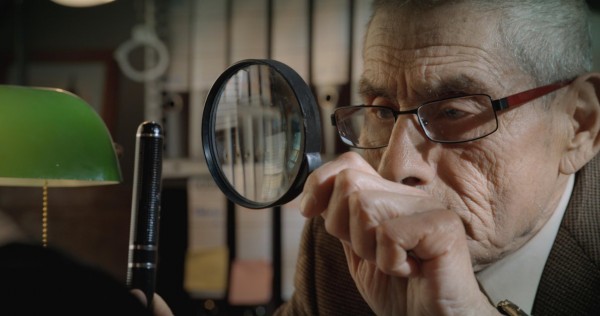
SERGIO CHAMY IN THE MOLE AGENT
An old man is set to spy on an old folks' home in this Chilean documentary hybrid
This is a clever concept that doesn't quite convince, though it does wind up providing a series of disarmingly closeup glimpses of an old people's home at the level where the old people sit around and are lonely and sometimes quite lost, even though tended to caringly by staff.
Ostensibly, Silvio is hired by a private detective, Romulo, who in turn has been hired by a lady to check and see if her mother is being properly cared for in the home.
It's initially amusing to see half a dozen men ages 80-90 being interviewed for this job and trying to convince they're capable of being undercover agents. The guy chosen, Silvio, has a precise quality, is on the ball, tidily dressed, and mannerly: good choice! He even seems to pick up on how to use a smart phone and several spy recording devices. This whole thing is a very novel idea. However, the old folk's home plainly is aware that they're being filmed. What we see is not just from a hidden camera, though as part of the film we hear Silvio's phone calls and messages to his detective boss and see his secret videos. His tour of duty is to be three months.
There is one human value to Silvio's job. He has, reportedly, lost his wife just a few months earlier. It does him good to get out of the house, away from being constantly reminded of his late spouse. In the home there are 40 women and 4 men, and Silvio's instantly the most "eligible" man and thus the object of constant admiration, attention, even love from the old ladies. He is fussed over and celebrated - exaggeratedly so. He's made, like a prom king, "king" of the home, and later given a spectacular birthday party. He is to spend three months here. How sad the ladies will be to see him go!
The "blanco," the target, turns out to be a very unfriendly old lady, who rarely speaks to anyone and spends most of her time in her room. There is little to report on, but also nothing discernible wrong in her treatment. The bulk of what will seem a pretty long and repetitious 84 minutes is devoted to Silvio's interactions with the old ladies and the cameraman's observation of them.
Early on one lady observes that she finds it sad when a man who is capable of coping on his own chooses to check into a place like this, a very telling point. Silvio seems to be a great help here providing cheer and support to the others. Obviously this fills a need for him, too. He was lonely at home. He perhaps isn't here.
The filmmakers lean toward observation of old ladies who either are quite enamored of Silvio, or are losing their marbles. Various ones believe their mothers are still alive and keep calling for them, to be taken home. One of them cannot remember if her family has visited her or not. Silvio checks, and finds no one has visited her all year. It's pathetic and sad to contemplate such loneliness and uselessness. It's sad to realize that many old lives are like this and many old people's homes are like this. The cute premise of the film goes sour after a while, despite the self possession and good cheer of the protagonist.
The Mole Agent/El agente topo 84 mins., debuted Jan. 2020 at Sundance, playing at 15 other festivals, including New Directors/New Films, as part of the delayed virtual pandemic version of which it was screened for this review, chosen as Closing Night Film for ND/NF. Metacritic: 71%. Chile's Best International Feature Oscar entry.
Last edited by Chris Knipp; 12-14-2020 at 10:08 AM.
 Posting Permissions
Posting Permissions
- You may not post new threads
- You may not post replies
- You may not post attachments
- You may not edit your posts
-
Forum Rules





 Reply With Quote
Reply With Quote






Bookmarks